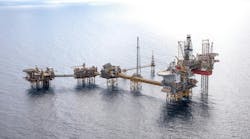Raising supplemental bond requirements damages the profitability of small independents while reducing liabilities for previous lease owners in the Gulf of Mexico.
The higher bonding requirements may happen as the US Minerals Management Service assesses an updated formula for calculating bonding requirements that have been in place since the early 1990s.
The MMS requires offshore oil and gas operators to procure bonds to ensure that they meet their regulatory obligations.
Companies in the gulf in 2008 held about $1.2 billion in bonds. Supplemental bonding ensures that operators meet their decommissioning obligations and in 2008 accounted for the largest bond type at $556 million, followed by area-wide development at $426 million.
Of the 120 operators that produced oil or gas in the gulf in 2008, 47 carry supplemental bonds and produce 2.5% of the gulf's oil and 11.7% of the gas.
A recent study1 developed risk-adjusted bonding tableau for assisting the MMS in assessing decommissioning liability and supplemental bonding requirements.
This first part of a two-part series discusses potential effects of an increase in the required bond levels. It provides an overview of the supplemental bonding industry in the gulf and uses MMS data and interviews with industry participants.
Part 2 will discuss risk-adjusted alternatives for implementing the bonding mechanism.
Surety bonds
Oil and gas operating companies on the Outer Continental Shelf have an obligation to plug and remove all structures on a lease within 1 year of the end of production, unless the lease is unitized, in suspension, or the structures serve a useful function for other operations.
The MMS requires that companies that do not meet a certain financial threshold provide a surety bond that ensures that funds are available for plugging and abandoning wells and removal operations at the end of the lease in the event of bankruptcy.2
Surety bonds are a method for enforcing contracts and are well suited for ensuring environmental compliance. There are several types of bonds used in the offshore oil and gas industry, which are also known as P&A bonds or supplemental bonds.
Surety bonds are agreements among three parties. These parties are the offshore operator (principal), which is obligated to conduct decommissioning activities in accordance with its lease agreement, the MMS, which acts as an agent of the landowner and is required to ensure successful operations (obligee), and an insurance company (surety), which ensures that money exists to complete decommissioning activities, regardless of the financial capacity of the principal.
The surety is only responsible for the insured amount, thus the bonds may not cover the total decommissioning costs.
The US Treasury department must certify the insurance company in order for it to write bonds and the US Treasury also gives it an underwriting limit, which is the maximum amount of liability that the surety can insure.
Surety bonds are good methods of ensuring compliance with regulations but only serve this purpose for companies that pose a bankruptcy risk. If a company has the means to comply with government regulations, it likely will do so. Otherwise the government, as the owner of mineral rights, could exclude the company from future land use and could sue the company to recover the decommission costs.
Thus, surety bonds are only efficient for firms that stand a risk of bankruptcy. As a result, MMS only requires small producers to procure supplemental bonds.
Bond market
Surety bonds are a type of insurance. Unlike more familiar forms of insurance, however, surety bonds transfer risk from the obligee to the surety, not from the principal to the insurer as in traditional insurance.
Surety bonds also often have indemnity clauses that allow sureties to collect money if they are forced to pay out the bond. Standard forms of insurance do not contain these clauses. It is, however, difficult to collect losses from companies that cannot fulfill a bonding obligation due to bankruptcy.
The premiums in the surety industry are not intended to cover losses to the same degree as premiums in the traditional insurance industry. That is, a large share of the premiums in the surety industry actually consists of fees for the underwriters. As a result, the surety industry expects less frequent losses than the insurance industry.
According to industry sources, about one-third of the premiums sureties collect are available for losses. The other two-thirds are associated with taxes, reinsurance, overhead, and salaries.3 Thus, a surety company that charges 2% on a given sized liability has to collect about 150 annual premiums (on similarly sized liabilities) to cover a single loss.
For example, if a surety covers a $1 million liability and collects $20,000/year in premiums, about $6,666/year is for covering losses. Thus, a surety would need 150 premium payments of 2% on a $1 million liability to pay for a single loss. Surety bonds are sometimes thought of more as a line of credit than a type of insurance.
Premiums in the total surety market in the US exceed $3.5 billion/year.4 Bonds written fulfill a large number of contractual and commercial obligations. Most large insurance companies have a surety department that underwrites construction contracts and other commercial sureties. The offshore oil and gas surety market in the gulf is a small fraction of the overall surety market, less than 1% if one assumes $556 million in supplemental bonds at 3% premium rate gives $16 million in premiums.
The supplemental surety bond market is itself a fraction, about 50%, of the offshore oil and gas surety market. The accompanying box shows how the industry determines rates.
Table 1 provides information on the supplemental bond market based on MMS data. In 2008, 73 operators held $556 million in supplemental bonds. The bond size averaged $7 million/company, and these 73 companies produced 2.5% of the gulf's oil and 11.7% of the gas.
Despite the small size of the market, the health of sureties is critical for oil and gas activities in the gulf. The sureties that underwrite supplemental bonds are generally the same companies that underwrite other bonds used for other forms of financial security.
General lease bonds
The MMS requires operators and lessees to obtain surety bonds to cover a variety of contractual obligations. These bonds may be either area-wide (covering a company's area-wide operations) or lease-specific. Unlike supplemental bonds, the bonds have a standard value for all lessees and operators cannot exempt out of the bonding requirements.
In general, the bond value increases with increasing development. All lessees must initially furnish $50,000/lease bonds ($300,000 area-wide) with bond requirements increasing to $200,000 ($1 million area-wide), and $500,000 ($3 million area-wide) during exploration and development, respectively.
The regulations require bonds of $300,000 for operators of pipeline right-of-ways and $500,000 for right of use easements.5
Tables 2 and 3 summarize the gulf surety bond industry in 2008. Gulf companies held about $1.2 billion in bonds. The values are dynamic and will change as companies lease new areas, trade assets, and add or remove infrastructure.
In 2008, supplemental bonding was the largest bond type at $556 million, followed by area-wide development at $426 million (Table 2). All other bond categories contributed 18% of the total bond amount.
Fifty surety companies hold $1.2 billion in bonds (Table 3). The largest sureties in the gulf include RLI Corp., Travelers Casualty & Surety Co. of America, and US Specialty Insurance Co. (IndemCo), which combined hold 63% of the market.
There are 448 bonded companies with average total bond coverage of $2.7 million. Because of area-wide bonding, large operators are not particularly burdened by bonding requirements.
Meeting obligations
MMS estimates the decommissioning costs for each lease and requires that if at least one working interest owner is not financially capable, operators either acquire surety bonds, set up escrow accounts, or acquire US Treasury bonds to meet their decommissioning liabilities.2
The breakdown in 2008 for meeting the obligations was 87% surety bonds, 11% trust accounts, and slightly more than 1% US Treasury bonds.
Operators use trusts or treasury bonds if their liabilities are too extensive to be covered by the available sureties or while they are in the process of obtaining surety bonds.
MMS does not allow letters of credit, but companies often use LOCs as collateral for surety bonds.6 LOCs differ from surety bonds in that the bank issuing an LOC usually requires the principal to have the value of the LOC in its account at all times. Surety bonds typically do not have this requirement.
Regulations allow large, financially stable companies to receive waivers for supplemental bonds. Companies with waivers in the gulf include all majors, large independents, and several other companies that account for 97.5% of the oil production and 88% of gas production during the first 6 months of 2008.
MMS also may exclude a company from supplemental bonding requirements if it has a guarantee by a third party that meets these standards, which often occurs when a company is a subsidiary of a larger company. As a result, the only companies that require supplemental surety bonds are relatively small ones with relatively low, usually less than $20 million, total liabilities.6
Of the 120 operators that produced oil or gas in the gulf between January and October 2008, 47 carry supplemental bonds. In addition to these 47 companies, another 26 had supplemental bonds but were not producing. These companies may be developing property or were pipeline operators.
Table 4 shows the 30 companies with the largest supplemental bond liabilities on the OCS. Together, they account for 87% of the total supplemental bond liability of $556 million.
From the surety perspective, there are both positive and negative effects of the MMS exemption rules. The fact that large companies exempt out of supplemental bonding removes a large part of the market and means that only companies needing these bonds are those for which insolvency is a real concern. The large companies exempted from supplemental bonds, however, hold enormous liabilities, liabilities that the current supplemental bond companies could not underwrite.
If a company defaults and cannot cover its decommissioning liabilities and there are no previous leaseholders on the lease, the regulations obligate the surety either to decommission the site or pay MMS the full value of the bond.
The surety may decide that it can decommission the site through a private contractor for less than the full value of the bond.7 In any case, the surety liability will not exceed the amount of the bond.
Bonding companies
Travelers, RLI, and IndemCo dominate the US offshore supplemental bond market (Table 5).
Travelers, with the largest market share, is by far the largest company with the most assets. About two thirds of its bonds are for one company, Nexen Inc., with the remainder split among three other companies. Thus, Travelers has a small number of clients and a market share primarily associated with companies that may be too large for other market participants to insure.
IndemCo is a small Houston-based insurance company that specializes in writing surety bonds for the energy industry. It is a subsidiary of HCC Insurance Holding Inc., a large multinational insurance company with assets of $8.2 billion.
IndemCo has $100 million in supplemental bonds. Offshore supplemental bonds make up a small, about 5%, share of IndemCo's total business and are a tiny fraction of HCC's total liabilities.3
RLI is the only other company that regularly writes offshore supplemental bonds and probably has the largest share of the supplemental bond business. RLI writes several bonds outside the energy industry and specializes in niche surety markets.
RLI is a medium-sized insurance company and holds $140 million in offshore supplemental bonds, which is a small fraction of its total business.
During the first half of the decade, several companies moved out of the surety industry in general and the mineral surety industry more specifically. This occurred because of a general tightening of the surety industry following the insurance losses associated with the Sept. 11, 2001, terrorist attacks and the bankruptcies of Kmart Corp. and Enron Corp.8
The loss of capital associated with these events triggered a conservatism in the insurance industry that led large insurers to move out of high-risk sureties of the mineral and energy industry.
Part of the reason for the small number of insurers in the offshore supplemental bond market is the skill needed to underwrite policies. The viability of an offshore operator is associated with the number, size, and production of its offshore leases and associated liabilities. A traditional surety agency may examine the financial records of an offshore operator and find no way to underwrite a bond, whereas an agency with offshore supplemental bonding experience may pay less attention to company's traditional financial records and focus on the production data and operating cost when determining a company's financial viability.
Additionally, a surety bond is a line of credit based, in part, on the character of the principal, and having a personal knowledge of companies has value. As a result, underwriters with a thorough knowledge of the offshore oil and gas industry have an advantage over those without such experience.
A surety company's available capital and the US Treasury, which certifies sureties to bond projects for the federal government, limit the liabilities that it can underwrite. Thus, sureties have to reinsure themselves to reduce their own liability and continue to underwrite bonds.
Sureties have to convince reinsurers that their liabilities are worth the risk; that is, they have to sell their underwriting abilities, their ability to estimate risk, to reinsurers.
The complexity and skill required to underwrite supplemental bonds mean that only those underwriters with a strong understanding of the offshore oil and gas industry will obtain reinsurance for their liabilities.
Changing requirements
Increasing the requirements of supplemental bonds will raise the liability of a company without changing its financial status. This will make it difficult for sureties to bond new applicants or to increase the bonding amounts for current bondholders.
As a result, sureties likely will require collateral; in some cases they will require collateralization of 100% of the increase. This will mean that small independent production companies will have to provide large amounts of cash, which may or may not be possible.
Even if sureties do not require operators to collateralize their increased bonds, the premium will increase. This will lower a company's profit and reduce its available capital for investing in exploration or development.
It is plausible that some of these companies will be unable to secure bonds and thus will be unable to operate. Importantly, these small production companies generally fill their own niches and compete mostly with one another, not with large multinational oil companies.
Many of these small companies buy leases after larger companies no longer obtain a sufficient rate of return or for other reasons want to divest property. As a result, if too many small producers find themselves unable to operate in the gulf, there is no ready replacement and production from this group of operators could suffer.
Small companies currently are the primary customers of the supplemental bond market. If fewer small production companies operate on the OCS, sureties would have less business.
Increasing the supplemental bond costs, however, would also cause a smaller proportion of companies to qualify for MMS exemptions. This could force additional companies to need supplemental bonds, which may increase the size of the supplemental bond market.
It is important to note that previously exempt companies may no longer have the value to liability ratio that they had before and thus may be no less of a risk than the smaller companies they replaced.
If the total bond value increases, then either the companies currently writing these bonds could add capacity or other surety companies could enter the market. It seems unlikely that new companies would join the industry, given that risks of underwriting would only increase with increasing liabilities. Instead, it seems more likely that the sureties already writing these bonds would try to accommodate these larger liabilities. This obviously would increase their revenues from increased premiums.
The size of any one liability that it can underwrite places the limit on the supplemental bond industry. Estimates of the total liability vary, but it is thought that the underwriting capacity of the entire industry has a $50 million limit for a particular company.3 6 7 This is consistent with the data in Table 4 that suggest that only Travelers can insure large liabilities. Thus, an operator with current $15 million liabilities may readily obtain a bond, but if its P&A liabilities increase to $60 million, it may have difficulty in obtaining a bond due to the small size of the surety industry. These operating companies might have to establish trusts instead.
Alternatively, increasing the MMS bonding requirements may have a small effect on the bonding industry or the independent producers. Before the hurricane seasons of 2004 and 2005, RLI estimated liabilities independent of the MMS formula. That is, its underwriters made their own decommissioning cost estimates and used it as the company's liability if that figure was less. Toppled platforms, however, greatly increase the costs of removal and P&A operations. As a result, RLI now assumes MMS bonding requirements represent its actual liability.
If bonding requirements increase dramatically, then sureties might again estimate liabilities independently. One reason sureties may reduce decommissioning costs relative to MMS projections is that decommissioning operations undertaken by large producers typically are more expensive than similar operations by independents.1 6
Mitigation
Oil and gas price increases allow small and medium-sized companies to generate more revenue and to qualify more easily for noncollateralized or partially collateralized bonds. Even if they do not qualify for noncollateralized bonds, high commodity prices may make it easier for them to produce the cash needed for collateral. This could mitigate the effects of an increase in bond costs and allow small operators to continue production on the OCS with higher bonding levels.
Conversely, volatility in commodity prices such as that experienced through 2008 might make it difficult for operators to budget for increased bond costs.
One way in which regulators could mitigate the effects of increasing bond requirements is by phasing in the increases over a period of time. For example, the regulation could allow a company that is required to increase its bond to $15 million from $5 million to increase the bond size in $2.5 million increments during 4 years. This would give companies time to produce the cash needed for collateral and would give sureties the time to add capacity.
Regulators could also change the requirements for supplemental bond exemptions to make them either more or less strict. They could do this by changing the current ratio of value to liabilities, changing the allowable debt-to-equity ratio, or changing the total required value of the company.
If MMS made these regulations stricter so that fewer companies qualified for exemptions, this could have a positive effect on the supplemental bond industry, as it would force companies with less risk to obtain surety bonds. These companies likely would be charged lower rates than smaller, riskier companies, but this would provide a source of relatively low risk accounts with which supplemental sureties could pay for losses.
Tighter limits on exemptions also would increase the number of companies needing supplemental coverage, especially the number of companies needing coverage near the limits of the market.
Lowering the exemption standards so that more companies were exempt from bonding would reduce the increase in capacity that the surety industry would need to build; however, it would also increase the government's risk of being forced to decommission a site at its own expense.
Prior leaseholders
Raising supplemental bond requirements damage the profitability of small independents while reducing liabilities to the previous owners of the lease.
Producers often sell leases down the food chain, but they cannot entirely pass all decommissioning liability to a new owner. That is, MMS can hold a former lease owner liable for platforms it did not even place on the OCS if the new lease owner goes bankrupt. Thus, increases in supplemental bonding requirements will protect both MMS and former leaseholders from having to pay for decommissioning.
References
- Kaiser, M.J., and Pulsipher, A.G., A review and update of supplemental bonding requirements in the Gulf of Mexico, US Department of the Interior, Minerals Management Service, TA&R Study No. 600, Herndon, Va., 2008.
- Notice to Lessees and Operators of Federal Oil, Gas and Sulphur Leases in the Outer Continental Shelf, Minerals Management Service, Washington, DC, 2003.
- Frank, E., personal communication, June 6, 2008.
- Surety, Surety & Fidelity Assoc. of America, Washington, DC, 2008.
- Supplemental Bond Procedures, Notice to Lessees and Operators—NTL No. 2008-N07, Minerals Management Service, Aug. 28, 2008.
- Die, R., personal communication, July 2, 2008.
- Chilson, G., personal communication, June 25, 2008.
- Fulton, T., Availability of Bonds to Meet Federal Requirements for Mining, Oil and Gas Projects, House Resources Subcommittee on Energy and Mineral Resources, Washington, DC, 2002.
- Duke, R., personal communication, June 25, 2008.
The authors
Mark J. Kaiser ([email protected]) is professor and director, research and development, at the Center for Energy Studies at Louisiana State University. His primary research interests are related to policy issues, modeling, and econometric studies in the energy industry. Kaiser joined LSU in 2001. He has a PhD in industrial engineering and operations research from Purdue University.
Brian F. Snyder is a research associate at the Center for Energy Studies at Louisiana State University. His interests are in the environmental impacts of the energy industry as well as issues of supply and cost in the oil and gas industry. Snyder joined the center in 2007 and is a doctoral candidate in ecology at the University of Georgia.
Rate determination
In the surety industry, rates generally range from 1 to 2.5%/year of the covered loss.9 In the offshore surety industry, rates typically range from 1 to 3%/year but may be as high as 5%.6 Offshore supplemental bonds often require collateral.
In the traditional insurance industry, insurers manage their risk by charging premiums or deductibles. In the surety market, rates are typically low and used primarily to pay the cost of doing business and deductibles are not an option.
As a result, sureties use increasing rates of collateral to decrease their risk. In some cases, sureties may require bonds to be 100% collateralized, either through cash deposits or through letters of credit. In this case, the surety serves not so much as an insurer, but as a banker or middleman, holding on to property (either cash or an LOC) and using its reputation and collateral to ensure that the principal's obligations will be met.
One way to obtain a rough estimate for the rate that a surety might charge a principal is to take the interest rate a company typically would be asked to pay on a loan, subtract the LIBOR rate, and take half of the remainder.
For example, if the LIBOR is 3%, and a company is charged 7% on its loans, then a surety might charge 2% of the insured losses.3
The Surety & Fidelity Assoc. of America has published rate tables as guidelines for the construction surety industry. These rates decrease from 2.5% for the first $100,000 of a bond to less than 1% for bonds over $5 million. These guidelines probably are too simplistic for offshore supplemental bonding because of risks involved and the fact that the success of an offshore oil company is linked closely with the geology and production potential of a lease site.







